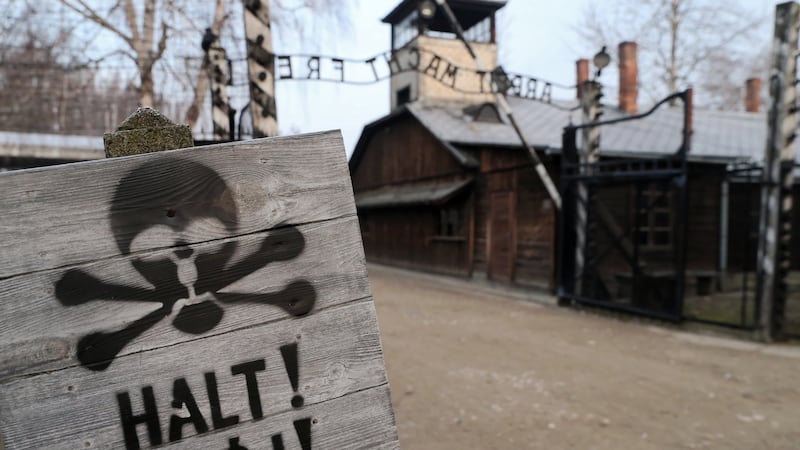Exactly 75 years after the liberation of Auschwitz-Birkenau, 100 elderly survivors gather one last time here on Monday: to remember the dead of the former Nazi extermination camp and to pass the torch of remembrance on to a new generation.
At about 3pm on January 27th, 1945, Red Army soldiers from the 322nd Rifle Division arrived at Auschwitz-Birkenau complex where some 7,000 gaunt, ill prisoners remained. Many thousands more had been been driven out by the SS on a so-called death march.
One of those marchers returning today, crisp winter sunshine dancing between the naked birch trees, was 95-year-old Ralph Hackman. He was born in 1925 in Radom, near Warsaw. One-third of the pre-war city's 90,000 population was Jewish. Just 3,000 survived, like him.
He was sent to Auschwitz as a terrified 17-year-old and worked in the shadow of the gas chambers and incinerators where almost one million Jews, tens of thousands of Poles, Sinti, Roma and homosexuals were murdered.
He had heard whispers about Auschwitz from neighbours in the Jewish ghetto erected in Radom. Now he was here. After being tattooed and photographed he was set to work on construction, expanding the death factory capacity.
“We woke at 4.30 and when we went to work we were not sure if we would come back – every minute of every day you were fighting to be alive,” he said. “Anyone who stopped working, they picked them off, shot them in the neck and . . . choked them to death.”
Gas chambers
He saw everything in Auschwitz: prisoner rebellions against cruel SS officers; the first tests of poison gas on Russian prisoners of war; the arrival of SS head Heinrich Himmler to inspect the efficiency of the new gas chambers and incinerators with a capacity of up to 6,000 bodies a day.
He worked in the reception area where people were selected for death. His job was to pick up the clothes they left behind.

“I probably saw 300,000 Jewish people perish right in front of me,” he said in a low voice. When the SS couldn’t accommodate all new arrivals in the gas chambers, or when they ran out of Zyklon B pellets, he said some prisoners – in particular children – were thrown, alive, into the crematorium.
For most, life ended – naked and terrified – in a gas chamber, disguised as a shower room.
“In 20 minutes it was all over, they opened the doors and the bodies just fell out,” said Hackman. “This what I saw every day. It was just killing.”
He was one of the prisoners who was evacuated from the camp in January 18th, and began days of trudging, barefoot, through the snow as SS officers shot anyone who struggled to keep marching. For Ralph Hackman the horror of Auschwitz ended in a field, and a passing remark from a Russian soldier they met, saying the camp had been liberated.
Living in Washington DC, he was unable to speak about his past until a business partner asked him to speak at his granddaughter's school 20 years ago. Now he is a regular speaker at the Holocaust museum in the US capital, and is honoured to be in Poland for Mondays's event.
“I saw things in Auschwitz that I’ve never seen in any books, and it is just a real relief to talk about it,” he said. “For young people to ask questions, it means so much that they have interest to do that.”
Preservation of memory
The questions of young people’s interest, information and the preservation of memory hang heavy over Monday’s ceremony, the last major anniversary when survivors will be present.
Despite decades of films, books and places of information like the Auschwitz memorial, a survey this year found that more than a fifth of US millenials (22 per cent) either hadn’t heard of or were unsure what they knew about the Holocaust.
Almost half of US millenials (49 per cent) cannot name one concentration camp or ghetto and two-thirds of them (66 per cent) had never heard of Auschwitz.

Similar surveys in France and Austria, also by the Jewish Claims Conference, show similar levels of ignorance.
A majority of total French respondents (57 percent) and Austrians (56 per cent) do not know that six million Jews were killed during the Holocaust – jumping to 69 per cent and 58 per cent among French and Austrian millennials.
These are alarming figures, particularly for Holocaust survivors like Charlotte Knobloch, head of the Munich Jewish community and former president of the Council of Jews in Germany
“We can already see where diminishing memory leads us, and anti-Jewish sentiments and anti-Semitic crimes are once again on the rise,” she said.
Remaking it
For her, the name Auschwitz will forever be an indelible stain – on the German nation but on the whole of humanity who failed to prevent what happened here.
"It was Primo Levi, a survivor, who once said that those who would deny Auschwitz would be ready to remake it," she said. "It is necessary to know today and it will continue to be necessary in the future."
As well as the 75th anniersary of the liberation of Auschwitz-Birkenau, Monday marks the 20th anniversary of the adoption of the Stockholm Declaration establishing an education, remembrance and research body, the International Holocaust Remembrance Alliance. And 15 years ago the UN adopted this date as International Holocaust Remembrance Day.
More than 40 delegations have confirmed attendance, including President Michael D Higgins. He follows former president Mary McAleese, who attended the 60th anniversary ceremonies in 2005, and Minister for Foreign Affairs Charlie Flanagan, who attended in 2015.










